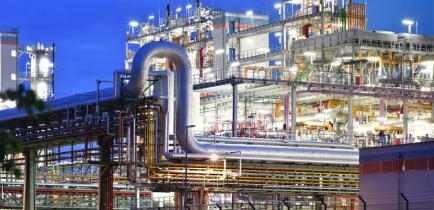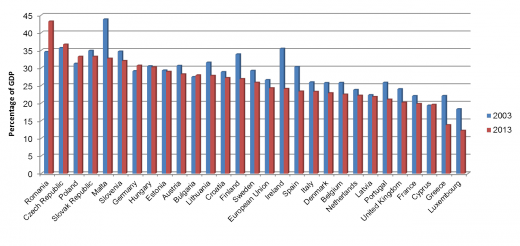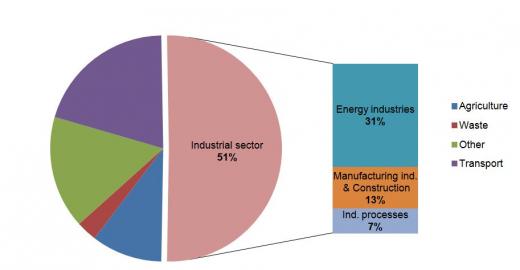Issues:
Sectors:
Keywords:
1. Current figures
1.1 Industry accounts for 25 percent of gross domestic product (GDP)
The industrial sector consists of three main categories of activity:
Industrial activities have a significant contribution to the GDP of the European Union (EU), currently accounting for 24.3%3. The industrial share of GDP for individual Member States is illustrated in Figure 1 below, comparing its development in the decade 2003-2013. It is evident that in most cases the industrial share has declined within the abovementioned period, with only a few exceptions of Romania, the Czech Republic, Poland, Germany and Bulgaria.
* Due to lack of data for 2013, data from 2010 were used in the cases of Malta, Lithuania and Latvia, and data from 2008 were used for Malta
** Industry comprises of mining and quarrying, manufacturing, electricity, water, and gas, according to OECD definition, available at: https://stats.oecd.org/glossary/detail.asp?ID=1343
1.2 Industry responsible for more than 50 Percent of total EU emissions
Industrial sector emissions of greenhouse gases (GHGs) are dominated by energy and process related CO2, but also include CH4, N2O, fluorinated gases (HFC, PFC, SF6), with the latter emissions concentrated in the chemical industry4. In the EU-28, CO2 accounted for over 94% of CO2-equivalent GHG emissions in the industrial sector in 20125.
Industrial emissions account for a considerable share of total GHG emissions in the EU6, exceeding 50%. The share of industrial GHG emissions in the EU is illustrated in Figure 2 below, as well as a further breakdown according to source of emissions7.
2. Treatmentof industrial GHG emissions in EU policy
2.1 Fluorinated greenhouse gases banned in new equipment
Industrial greenhouse gas emissions of fluorinated greenhouse gases (F-gases) are controlled by the "MAC Directive"8 on air conditioning systems used in cars and vans, while the "F-gas Regulation"9 covers all other key applications in which F-gases are used.
The MAC Directive prohibits the use of F-gases with a global warming potential of more than 150 in new types of cars and vans introduced from 2011 and in all new cars and vans produced from 2017.
The F-gas Regulation wants to achieve prevention of leaks from equipment containing F-gases and avoid the use of F-gases in some applications where environmentally superior alternatives are cost-effective. Among the measures provisioned are restrictions that apply to the procedures of marketing and use of a range of products that contain F-gases. In May 2014, the Regulation has been substantially tightened10; it now bans the use of F-gases in new equipment where viable climate-friendly alternatives are readily available.
2.2 Directives lay down minimum requirements for certain industrial activities
The main piece of legislation regulating emissions from industrial installations is the Industrial Emissions Directive (IED). The IED entered into force in January 2011 as a recast of the former Integrated pollution prevention and control (IPPC) directive, combined with 6 sector-specific directives, which lay down specific minimum requirements for certain industrial activities. Installations covered under the IED Directive amount to more than 50.000, which require a permit to operate. In order for an industrial installation to be granted such a permit, an assessment must be conducted by the competent authorities of the Member States. Under the required integrated approach, the whole environmental performance of the plant must be evaluated for the granting of a permit, taking into account air emissions, water and land emissions, waste generation, raw materials use, energy efficiency, noise, accident prevention, as well as the site restoration following the end of its lifecycle.
2.3 Best Available Techniques (BAT) must be used
Permit conditions for each sector must be set and revised, based on the respective "BAT Conclusions". Within these documents, the Best Available Techniques (BAT) and the associated BAT Emission Levels (BAT-AELs) are defined for each particular industrial sector. Industrial installations must use the BAT, which are "developed on a scale which allows implementation in the relevant industrial sector, under economically and technically viable conditions" (Article 3(10)(b) IED). In specific cases, however, an assessment may indicate that, although the installation could stay within the level of emissions as set by the BAT, this would lead to increased costs that outperform the potential environmental benefits. In such cases, a certain amount of flexibility is thus provided for, allowing licensing authorities to deviate from BAT requirements. The definition of BAT has had repercussions for the development of benchmarks under the EU ETS, see below11.
2.4 EU emission trading system (EU-ETS) controls 45 percent of EU GHG emissions
The EU ETS is the key EU policy instrument for reducing industrial GHG emissions cost-effectively. It applies to heavy energy-using installations in power and heat generation, as well as several energy-intensive manufacturing industry sectors and commercial aviation, mainly dealing with CO2 emissions. In total, it includes more than 11,000 power stations and industrial plants across the EU, covering around 45% of total GHG emissions from the 28 EU countries12.
Participants must have an approved monitoring plan, according to which they commit to monitor their emissions and report on an annual basis. As far as industrial installations are concerned, the monitoring plan is incorporated in the approved permit that is also required13. In case participants do not surrender the appropriate amount of emission allowances that cover emissions generated by their activity, they have to pay severe fines.
Due to a repeated oversupply of allowances, initially due to lenient allocations on the national level, and from 2008 onwards due to the financial and economic crisis, allowance prices have declined significantly and only provide a limited incentive for emission reduction. Therefore, a temporary withdrawal of a number of allowances (so-called "backloading") has been agreed until 2019-2020, in order to increase demand. However, GHG emissions restrictions posed by the EU ETS have created competition between European and developing countries; the latter are not subject to such limitations. This situation can result in "carbon leakage", which specifically refers to businesses transferring their production to other countries with laxer GHG constraints, due to environmental costs14. In order to face this competitiveness issue, "production from sectors and sub-sectors deemed to be exposed to a significant risk of "carbon leakage" will receive more free allowances in the third trading period between 2013 and 2020."14
2.5 Carbon Capture and Storage is critical
Carbon Capture and Storage (CCS) is a technology designed to capture CO2 emissions produced from the use of fossil fuels in electricity generation and industrial processes, transport it and store it underground, so that it does not enter the atmosphere15. It is considered to be of crucial importance to industrial sectors such as cement, iron and steel, chemicals and refining, as it can also target their high share of non-energy related CO2 emissions that relate to industrial processes and cannot be reduced by energy efficiency measures.
CCS in industrial applications is projected to facilitate a reduction of CO2 emissions by up to 4.0 Gt a year, by 205016, which would consequently result to approximately 9% of the global reductions needed to halve energy-related CO2 emissions in 2050. Such an outcome would require the installation of CCS equipment to 20%-40% of industrial and fuel transformation plants by 2050. However, although the industrial community has been anticipating the introduction of financial incentives and support policies for CCS technologies, a suitable regulatory instrument has not yet been introduced by the EU.
3. Future trends
The "2030 framework for climate and energy policies"17, proposed by the Commission in January 2014 and agreed on by EU leaders in October 2014, raises the 2030 emissions reduction target of to 40% below 1990 levels. To achieve the target, sectors covered by the EU ETS will have to reduce their emissions by 43% compared to 200518. At the same time, the European Commission has set a goal of increasing the contribution of manufacturing to 20% of the EU GDP by 2020 in its 2012 Communication: "For an industrial renaissance"19. However, at 15.1% in 2013, the contribution of manufacturing to EU GDP has declined further and is a long way from the target. Some business groups have claimed that EU climate policies affect European industrial competitiveness, requesting a more balanced approach between the EU's industrial and climate policies.


